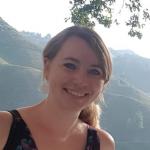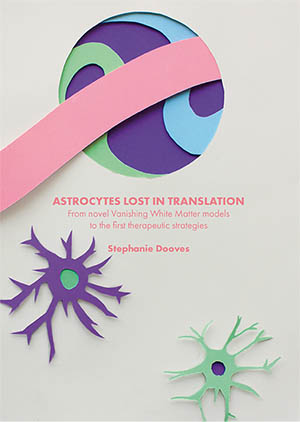Stephanie Dooves
Contact info
-
Address
VU University
De Boelelaan 1085, W&N Bldg, Rm G350
1081 HV Amsterdam
The Netherlands -
E-mail
-
Phone

Short CV
| 2018 – | Postdoctoral researcher | Amsterdam UMC |
| 2011-2018 | PhD candidate | VU University Amsterdam |
| 2013 | Visiting Research Scholar | Rowitch lab, UCSF, San Francisco, USA |
| 2009‑2010 | Exchange Honours Master Programme | VU University Amsterdam, Erasmus University Rotterdam and the Netherlands Institute for Neuroscience |
| 2008‑2010 | Master Neuroscience (cum laude) | VU University Amsterdam |
Research
My main research interest is in the contribution of glial dysfunction to brain disorders. During my PhD research I developed new experimental models and new therapeutic approaches for leukodystrophy Vanishing White Matter. As a postdoctoral researcher I am involved in 2 research projects. The first project is focused on 4H leukodystrophy, a rare genetic brain white matter disorder. Previous research suggests a role for neurons and oligodendrocytes in 4H pathomechanisms. We are using human stem cell models to study neuronal development and neuron-oligodendrocyte interactions. The second project is focused on Tuberous Sclerosis Complex (TSC) a multisystem disorder with manifestations in the brain. I am studying how (stem cell derived) glial cells contribute to TSC development.
Highlighted publications
Dooves S, van Velthoven AJH, Suciati LG, Heine VM. Neuron-glia interactions in Tuberous Sclerosis Complex affect the synaptic balance in 2D and organoid cultures. Cells, 2021
Warren EC, Dooves S, Lugara E, Damstra-Oddy J, Schaf J, Heine VM, Walker MC, Williams RSB. Decanoic acid inhibits mTORC1 activity independent of glucose and insulin signaling. PNAS, 2020
Dooves S#, Nadadhur AG#, Gasparotto L, Heine VM. Co-culture of human stem cell derived neurons and oligodendrocyte progenitor cells. Bio-Protocol, 2020
# Shared first authorship
Leferink PS#, Dooves S# Hillen AEJ#, Watanabe, K, Jacobs G, Gasparotto L, Cornelissen-Steijger P, van der Knaap MS, Heine VM. Astrocyte subtype vulnerability in stem cell models of Vanishing White Matter. Ann Neurol, 2019.
# Shared first authorship
Dooves S, Leferink PS, Krabbenborg S, Breeuwsma N, Bots S, Hillen AEJ, Jacobs G, van der Knaap MS, Heine VM. Cell replacement therapy improves pathological hallmarks in a mouse model of leukodystrophy Vanishing White Matter. Stem Cell Reports, 2019
Nadadhur AG, Alsaqati M, Gasparotto L, Cornelissen-Steijger P, van Hugte E, Dooves S, Harwood AJ, Heine VM. Neuron-glia interactions increase neuronal phenotypes in Tuberous Sclerosis Complex patient iPSC-derived models. Stem Cell Reports, 2019.
Dooves S, Bugiani M, Wisse LE, Abbink TEM, van der Knaap MS, Heine VM. Bergmann glia translocation: a new disease marker for Vanishing White Matter identifies therapeutic effects of Guanabenz treatment. Neuropathol Appl Neurobiol, 2018.
Dooves S, van der Knaap MS, Heine VM. Stem cell therapy for white matter disorders: don’t forget the microenvironment! J Inherit Metab Dis. 2016.
Dooves S#, Bugiani M#, Postma NL, Polder E, Land N, Horan ST, van Deijk AL, van de Kreeke A, Jacobs G, Vuong C, Klooster J, Kamermans M, Wortel J, Loos M, Wisse LE, Scheper GC, Abbink TE, Heine VM*, van der Knaap MS*. Astrocytes are central in the pathomechanisms of vanishing white matter. J Clin Invest, 2016.
# Shared first authorship *Shared senior authorship.
Heine VM, Dooves S, Holmes D, Wagner J. Induced Pluripotent Stem Cells in Brain Diseases. Understanding the Methods, Epigenetic Basis, and Applications for Regenerative Medicine. SpringerBriefs in Neurosciences. 2012, 2012, XV, 59 p. 7 illus., 6 in color.
